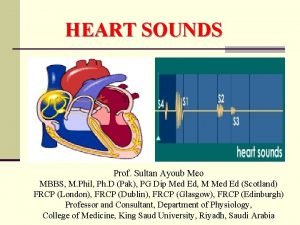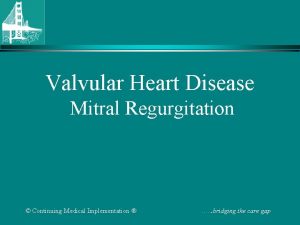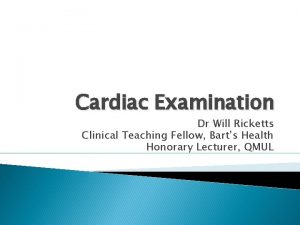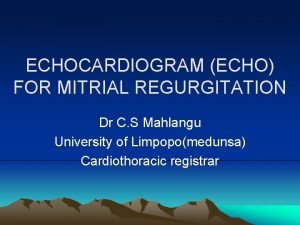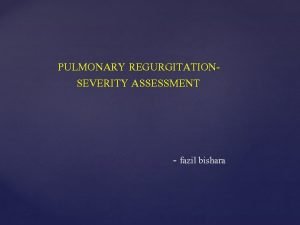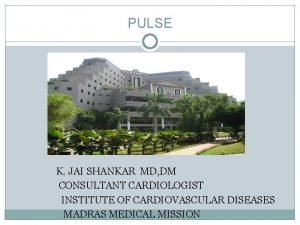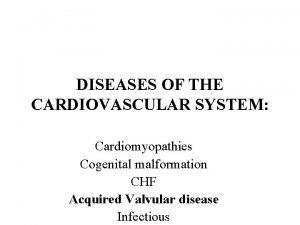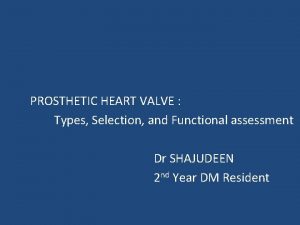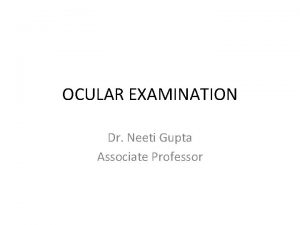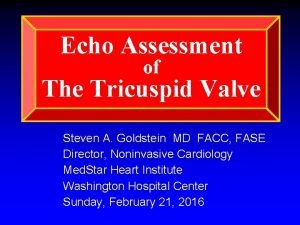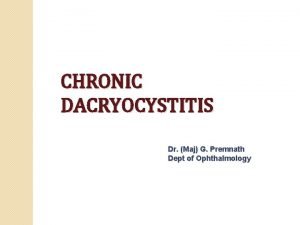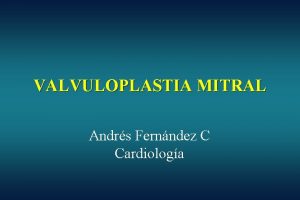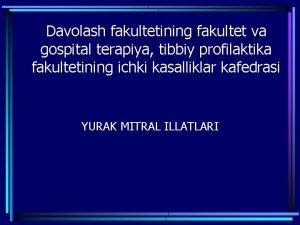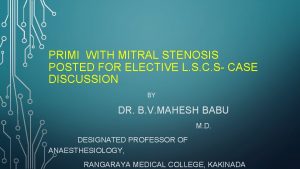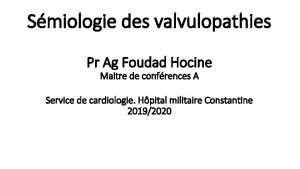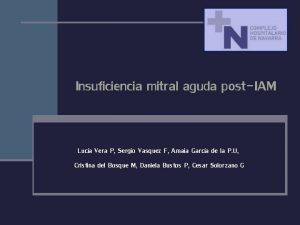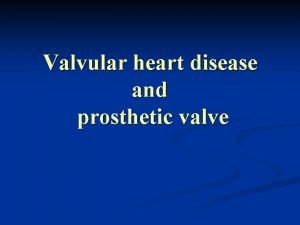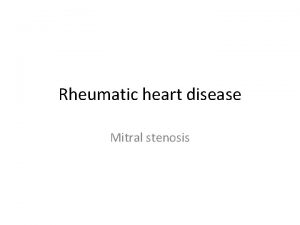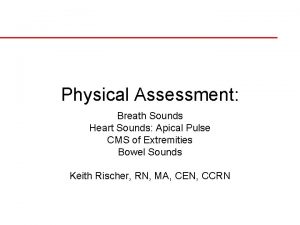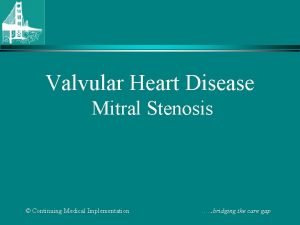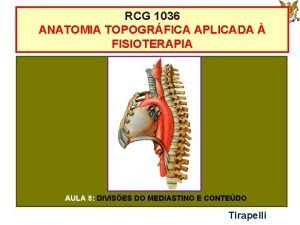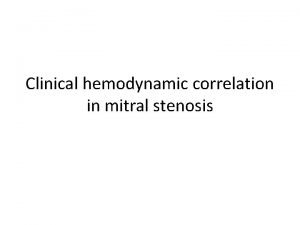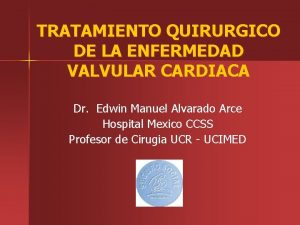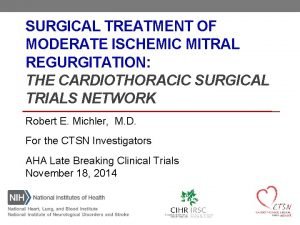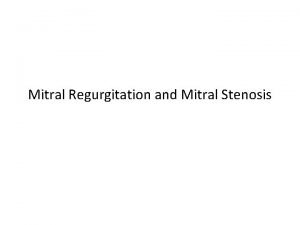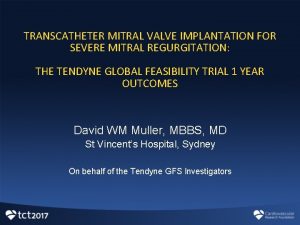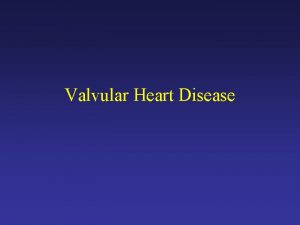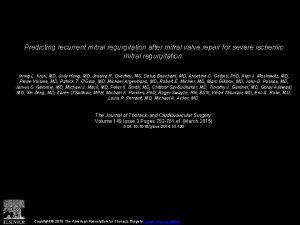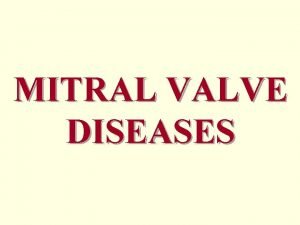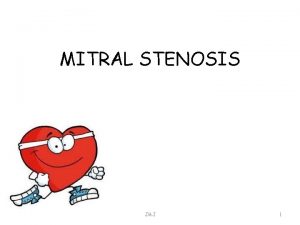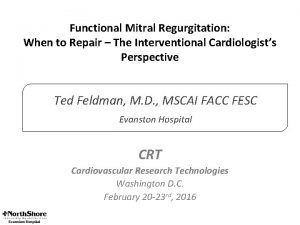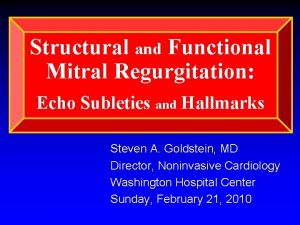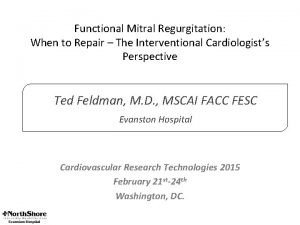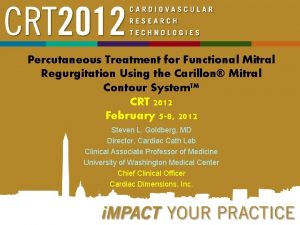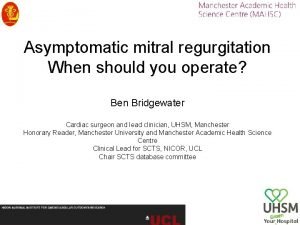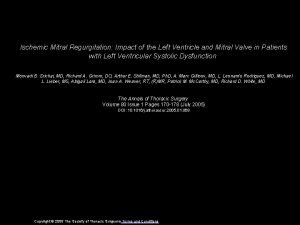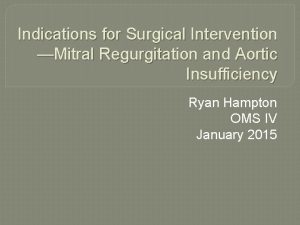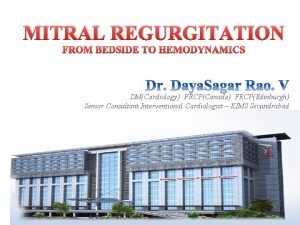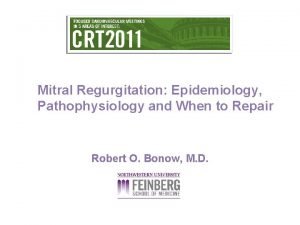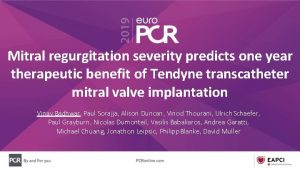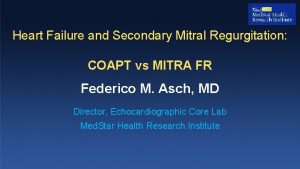Should We Treat Moderate Functional Mitral Regurgitation Anita



























- Slides: 27

Should We Treat Moderate Functional Mitral Regurgitation? Anita W. Asgar, MD MSc FACC Montreal Heart Institute

Functional mitral regurgitation • Ischemic MR – LV remodeling after myocardial infarction results in papillary muscle displacement, causing systolic tenting of the MV. Global LVEF does not have to be reduced; regional wall motion abnormalities with remodeling may result in sufficient MV tethering to cause severe MR, despite preserved LVEF. • Non-ischemic MR – most commonly due to long- standing hypertension or idiopathic dilated cardiomyopathy, is characterized by global LV dilation with increased sphericity and a centrally located regurgitant jet. Asgar AW, Mack M, Stone GW. J Am Coll Cardiol. 2015 Mar 31; 65(12): 1231 -1248.

Moderate Functional MR • How do we diagnose moderate FMR? – Echocardiography • “Neither mild nor severe” • Secondary or functional MR is often more challenging to evaluate • It is important to consider volume status, blood pressure, and other clinical variables such as clinical presentation and hemodynamic state.

Moderate MR Zoghbi et al, ASE Guidelines for Quantitation of Native Valvular Regurgitation, J Am Soc Echo 2017

Moderate MR Zoghbi et al, ASE Guidelines for Quantitation of Native Valvular Regurgitation, J Am Soc Echo 2017

Moderate vs. Severe FMR Moderate FMR Severe FMR

What is the impact of Functional MR? Observational Data

• • Following an MI, the incidence of CHF and of CHF/Cardiac death are higher in patients with ischemic or functional MR The presence of MORE than mild MR is independently associated with the incidence of CHF J Am Coll Cardiol 2005; 45: 260– 7.

In a population of 3264 consecutive patients undergoing isolated CABG with MR, the presence of mild or moderate MR was associated with increased risk of death or HF admission at median three year follow up, HR 1. 34, p<0. 001. Schroeder JN, et al. Circulation. 2005; 112[suppl I]: I-293–I-298.

• In a study of 3078 patients with a diagnosis of HF in Denmark from 2001 -2002 patients were evaluated for the presence and severity of MR and the impact on mortality. • 15% (n=452) of patients had moderate MR, and 4% (n=108) had severe MR • At 4. 5 years, total mortality was 54% in the cohort • HR for mortality in Moderate MR was 1. 21 (p=0. 006) compared to 1. 43 for severe MR (p=0. 004) • When analyzed by LVEF, at a cutoff of LVEF 25%, the presence of MR had a greater impact on mortality European Journal of Heart Failure (2011) 13, 1121– 1125

Should we treat Moderate Functional MR?

• Surgical trial of CABG vs. CABG + MVR in patients with moderate ischemic MR and CAD • The primary end point was the left ventricular end-systolic volume index (LVESVI), a measure of left ventricular remodeling, at 1 year. • At 12 months, the mean LVESVI among surviving patients was 46. 1± 22. 4 ml/m 2 in the CABG-alone group and 49. 6± 31. 5 ml/m 2 in the combined-procedure group (mean change from baseline, − 9. 4 and − 9. 3 ml/m 2, respectively ). N Engl J Med 2014; 371: 2178 -88.

• At 2 years, the mean (±SD) LVESVI was 41. 2± 20. 0 ml/m 2 in the CABG-alone group and 43. 2± 20. 6 ml/m 2 in the combined-procedure group (mean improvement over baseline, − 14. 1 ml/m 2 and − 14. 6 ml/m 2, respectively). • There was no significant between-group difference in the rank-based assessment of the LVESVI (including death) at 2 years (z score, 0. 38; P=0. 71). • In patients with moderate ischemic mitral regurgitation undergoing CABG, the addition of mitral-valve repair did not lead to significant differences in left ventricular reverse remodeling at 2 years. N Engl J Med 2016; 374: 1932 -41.

Why was this study negative? – Treating Moderate MR does not have an impact on ventricular remodelling OR Certain challenges impacted the overall benefit – The lack of core-lab adjudicated Moderate MR as inclusion criteria – Inclusion of significantly dilated LV may have impacted potential of LV remodelling J Thorac Cardiovasc Surg 2012; 143: 111 -7.

What can we learn from trials in severe FMR?

Trials of Mitra. Clip In Secondary MR 100% COAPT Mitra. Clip + MT MT alone 90% 80% OR [95% CI]= 1. 16 [0. 73– 1. 84] P=0. 53 70% 60% 54. 6% 51. 3% 40% 30% 20% 10% 0% 0 2 4 8 10 123 114 109 95 94 91 100% Mitra. Clip + GDMT alone 90% 80% HR [95% CI]= 0. 63 [0. 49– 0. 82] P<0. 001 70% 60% 50% 46. 5% 40% 33. 9% 30% 20% 10% 0% 0 12 Months No. at Risk: Control Group 152 Device Group 151 6 Death or HF Hospitalization (%) MITRA-FR 3 80 73 73 67 Control Group 312 Device Group 302 Obadia JF et al. NEJM. 2018 Aug 27. doi: 10. 1056/NEJMoa 1805374 9 12 174 215 153 194 Months No. at Risk: 86 81 6 244 264 205 238 Stone GW et al. NEJM. 2018 Sept 23.

COAPT vs. MITRA-FR COAPT (n=614) 41 ± 15 MITRA-FR (n=304) 31 ± 10 - <30 mm 2 14% (80/591) 52% (157/301) - 30 – 40 mm 2 46% (270/591) 32% (95/301) - >40 mm 2 41% (241/591) 16% (49/301) 31 ± 9 33 ± 7 101 ± 34 135 ± 35 EROA, mm 2 (mean ± SD) LVEF, % (mean ± SD) LVEDV, m. L/m 2 (mean ± SD) Obadia JF et al. NEJM. 2018 Aug 27. Stone GW et al. NEJM. 2018 Sept 23.

Proportionate vs Disproportionate MR? Courtesy P. Grayburn

COAPT vs. MITRA-FR vs. CTSN COAPT (n=614) 41 ± 15 MITRA-FR (n=304) 31 ± 10 CTSN (n=301) 20 ± 10 - <30 mm 2 14% (80/591) 52% (157/301) - - 30 – 40 mm 2 46% (270/591) 32% (95/301) - - >40 mm 2 41% (241/591) 16% (49/301) - 31 ± 9 33 ± 7 40 ± 11* 101 ± 34 135 ± 35 142 ± 43* EROA, mm 2 (mean ± SD) LVEF, % (mean ± SD) LVEDV, m. L/m 2 (mean ± SD) * Calculations based on data published in NEJM 2014 Obadia JF et al. NEJM. 2018 Aug 27. Stone GW et al. NEJM. 2018 Sept 23. N Engl J Med 2014; 371: 2178 -88.

Where do Moderate MR Studies Fit? CTSN Modified from P. Grayburn

Should we treat Moderate Functional MR? Maybe…using Transcatheter Repair

M R EVALUATION OF OUTCOMES OF MITRACLIP FOR THE TREATMENT OF LOW EJECTION FRACTION AND FUNCTIONAL MITRAL VALVE REGURGITATIONMODERATE MR 22/30

EVOLVE-MR Study Design Randomized trial of medical therapy vs. Mitra. Clip in patients with MODERATE FMR 23

EVOLVE-MR Study Endpoints PRIMARY ENDPOINT: • Change in indexed left ventricular end-diastolic volume (LVEDVi) from baseline to 12 months. SECONDARY ENDPOINTS: 1. Change in distance walked on a six-minute walk test (6 MWT) from baseline to 6 months and from baseline to 12 months 2. Change in mitral regurgitation severity from baseline to 12 months 3. Change in Quality of Life Assessment, Kansas City Cardiomyopathy Questionnaire (KCCQ) from baseline to 12 months 24

Should we intervene earlier for Moderate FMR? COAPT ERO > 40 mm 2 LVEDVi 100 ml/m 2 EVOLVE-MR MITRA-FR ERO > 20 mm 2 LVEDVi 135 ml/m 2

Where do Moderate MR Studies Fit? EVOLVE-MR CTSN Modified from P. Grayburn

Summary • The diagnosis of moderate MR requires a thorough echo evaluation and a multiparametric approach • The presence of moderate FMR has been associated with increased mortality and admissions for heart failure in observational studies • The only large randomized trial of surgical intervention in moderate ischemic MR did not demonstrate benefits in LV remodelling or mortality • Akin to the severe FMR literature, the presence of severe LV dilatation may indicate irreversible LV damage and may mitigate the benefits of MR reduction in moderate MR. • Further trials are required to understand the impact of treatment of moderate FMR on LV remodelling and outcomes.
 Systolic murmur
Systolic murmur Aortic regurgitation murmur
Aortic regurgitation murmur Mitral regurgitation symptoms
Mitral regurgitation symptoms How do we treat the life the life how we treat
How do we treat the life the life how we treat Left parasternal heave
Left parasternal heave Mitrial regurgitation
Mitrial regurgitation Jet fazil
Jet fazil Peripheral signs of aortic regurgitation
Peripheral signs of aortic regurgitation Tricuspid valve
Tricuspid valve Dvi aortic valve
Dvi aortic valve Regurgitation test
Regurgitation test Tricuspid valve leaflets tee
Tricuspid valve leaflets tee Lacrimal sac
Lacrimal sac Primary tricuspid regurgitation
Primary tricuspid regurgitation Valva mitral
Valva mitral Score wilkins estenosis mitral
Score wilkins estenosis mitral Mitral klapan prolapsi
Mitral klapan prolapsi Mitral stenosis echo guidelines
Mitral stenosis echo guidelines Mitral facies
Mitral facies Frémissement cataire diastolique
Frémissement cataire diastolique Insuficiencia mitral
Insuficiencia mitral Rvh cxr
Rvh cxr Malar flush mitral stenosis
Malar flush mitral stenosis Apical pulse and mitral valve
Apical pulse and mitral valve S2 os gap
S2 os gap Cicoide
Cicoide Pht mitral valve
Pht mitral valve Valvula mitral en paracaidas
Valvula mitral en paracaidas
